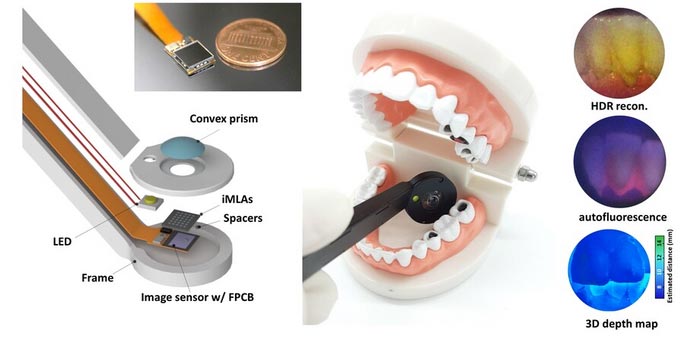Ultrathin dental camera inspired by insect-eye structure

A fully packaged ultrathin dental camera and multifunctional dental images.
Credit: The Authors, doi 10.1117/1.JOM.2.3.031202
Biologically inspired camera achieves diverse functional dental imaging with high dynamic range, 3D depth, and autofluorescence.
Conventional dental photography technology has had a limitation in using inconvenient tools such as mirrors and cheek retractors. Dentists require basic teeth images from various angles, such as right/left buccal and maxillary/mandibular occlusal, for dental health inspection. To acquire these images, patients feel discomfort because dentists must put a mirror into the mouth to capture the reflected teeth image through a handheld camera. Information such as tooth arrangement and the location of tooth decay can be obtained through this process. A compact intraoral dental camera can overcome the discomfort and scan the condition of teeth. However, due to the restricted depth of field and field-of-view, the conventional device has limitations in close-up imaging for observing tooth decay in detail and wide-angle imaging for capturing the entire arrangement of teeth.
Various species of compound insect eyes have superior visual characteristics, such as wide viewing angle and large depth of field with compact visual organs made up of tiny lenses. Insect eyes give inspiration for miniaturized cameras, and insect-inspired cameras can solve the problems of conventional compact cameras, such as limited observation range. However, previously developed insect cameras have drawbacks in low-resolution or limited functions.
As reported in the Journal of Optical Microsystems, researchers from Korea Advanced Institute of Science and Technology and Korea Photonics Technology Institute recently developed a novel wide-angle insect eye camera, the biologically inspired intraoral camera (BIOC), for assorted functional imaging. Using the device, assorted functional imaging was demonstrated to satisfy clinical needs.
The BIOC involves a new configuration of convex-concave lens and inverted microlens arrays (iMLA) and a single CMOS image sensor on a flexible printed circuit board in a handpiece holder. The convex-concave lens substantially increases the field of view up to 143 degrees, and iMLAs reduce optical aberration by the scaling law. In addition, the new camera overcomes many chronic issues of conventional intraoral cameras, such as limited depth-of-field, thick total-track-length, and limited functional imaging. In detail, the ultrathin dental camera can solve discomfort states owing to its thinness and observe teeth even in anatomically narrow regions. Also, clear dental imaging is achieved without image blur by emulating the insect vision feature of infinite depth of field even at close object distance. The BIOC offers multifunctional dental imaging, such as high dynamic range, 3D depth, and autofluorescence imaging, through the multichannel vision system.
The authors hope that the novel wide-angle insect eye camera contributes not only technical advances in biomedical engineering societies but that it also has significant impacts on such diverse vision applications as surveillance, smartphone, and drones. They anticipate a continuing expansion in applications in the future.
Read the Gold Open Access article by K. Kim et al., “Biologically inspired intraoral camera for multifunctional dental imaging,” J. Opt. Microsystems 2(3) 031202 (2022), doi 10.1117/1.JOM.2.3.031202.
Journal: Journal of Optical Microsystems
DOI: 10.1117/1.JOM.2.3.031202
Article Title: Biologically inspired intraoral camera for multifunctional dental imaging
Article Publication Date: 18-Aug-2022
Media Contact
Daneet Steffens
SPIE–International Society for Optics and Photonics
daneets@spie.org
Office: 360-685-5478
All latest news from the category: Medical Engineering
The development of medical equipment, products and technical procedures is characterized by high research and development costs in a variety of fields related to the study of human medicine.
innovations-report provides informative and stimulating reports and articles on topics ranging from imaging processes, cell and tissue techniques, optical techniques, implants, orthopedic aids, clinical and medical office equipment, dialysis systems and x-ray/radiation monitoring devices to endoscopy, ultrasound, surgical techniques, and dental materials.
Newest articles

Innovative 3D printed scaffolds offer new hope for bone healing
Researchers at the Institute for Bioengineering of Catalonia have developed novel 3D printed PLA-CaP scaffolds that promote blood vessel formation, ensuring better healing and regeneration of bone tissue. Bone is…

The surprising role of gut infection in Alzheimer’s disease
ASU- and Banner Alzheimer’s Institute-led study implicates link between a common virus and the disease, which travels from the gut to the brain and may be a target for antiviral…

Molecular gardening: New enzymes discovered for protein modification pruning
How deubiquitinases USP53 and USP54 cleave long polyubiquitin chains and how the former is linked to liver disease in children. Deubiquitinases (DUBs) are enzymes used by cells to trim protein…



